Abstract
A survey of 255 workers in four cottonseed crushing mills included a respiratory health questionnaire, allergy skin testing, and measurements of lung function over the Monday working shift. Atopy was defined as having two or more positive weal reactions to common inhalant antigens. Categories of exposure to dust were based on the stage of milling, and one category contained workers with continuous exposure to cotton dust derived from linters, the cotton fibres adherent to cottonseed. Atopy and exposure to dust were found to have significant interaction: large mean declines in FEV1 and FEF 25-75 occurred only in the workers exposed to linter dust who were also atopic. Skin-testing surveys in cotton textile mills have concentrated on specific cotton antigen reactivity and its first-order relations to symptoms. Our results indicate a need to identify atopic workers, and to search for interactions between atopy and other variables that may influence acute changes in expiratory flow rates.
Full text
PDF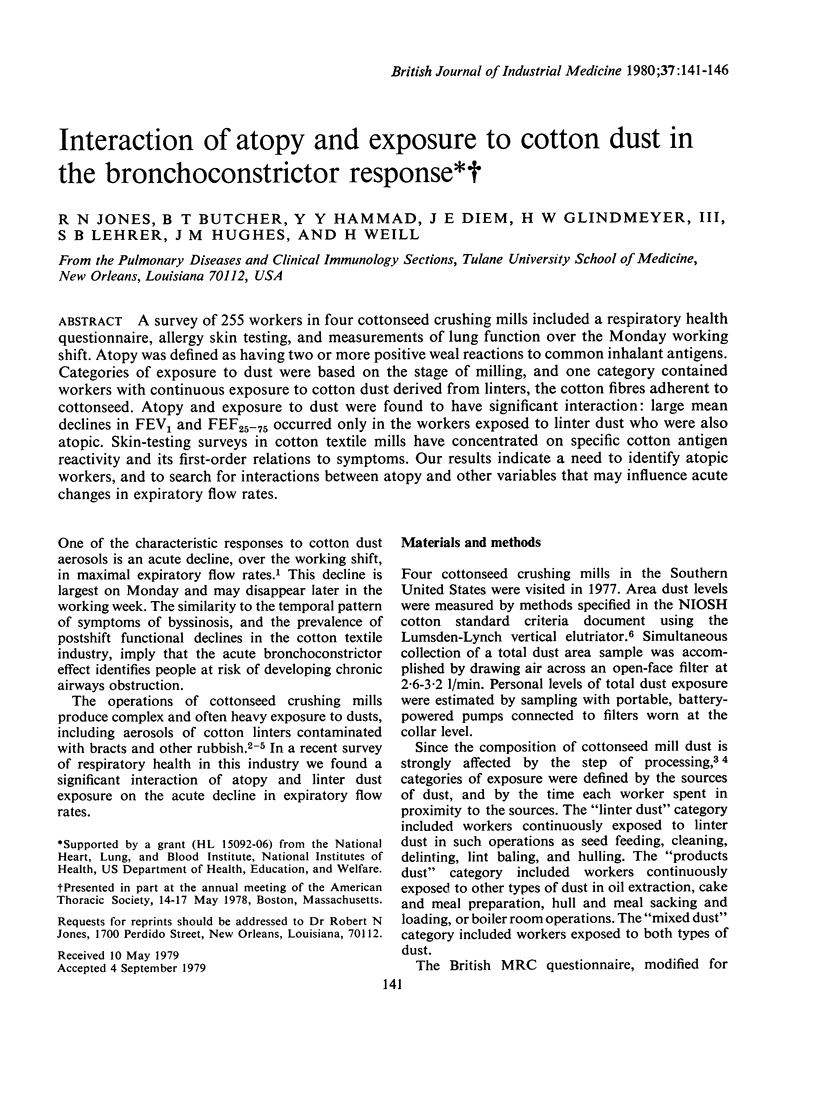
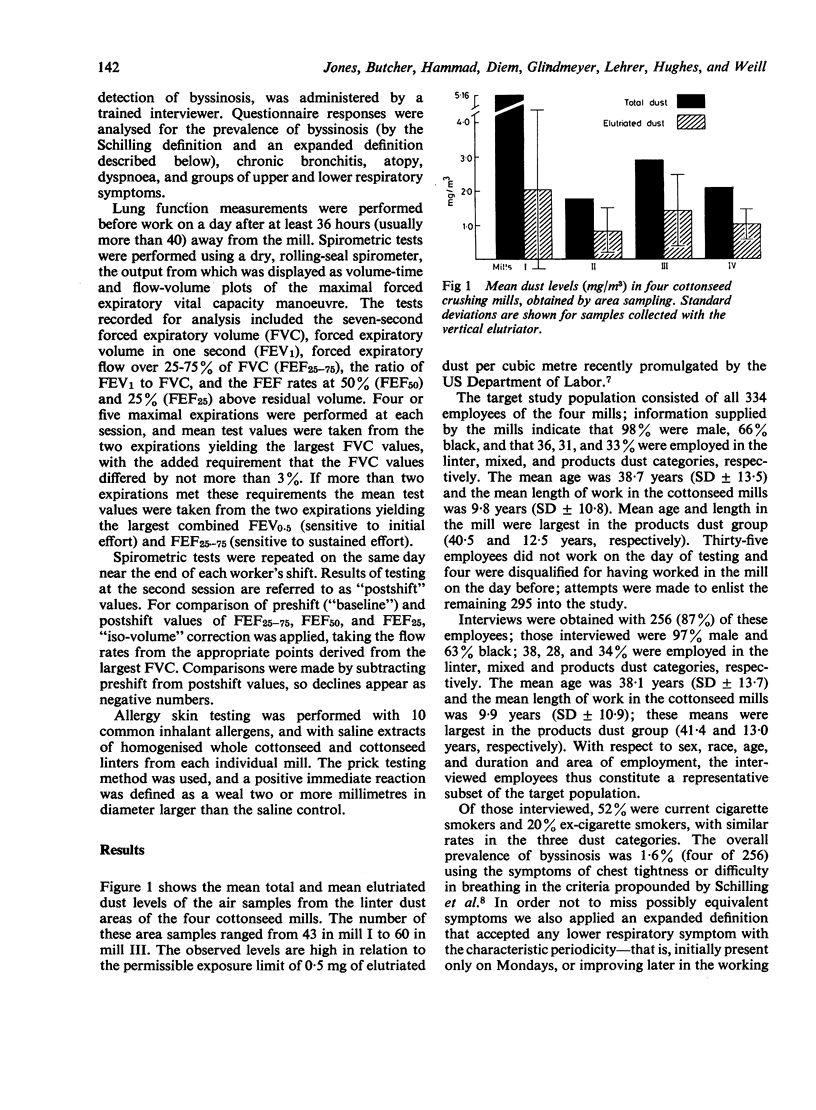
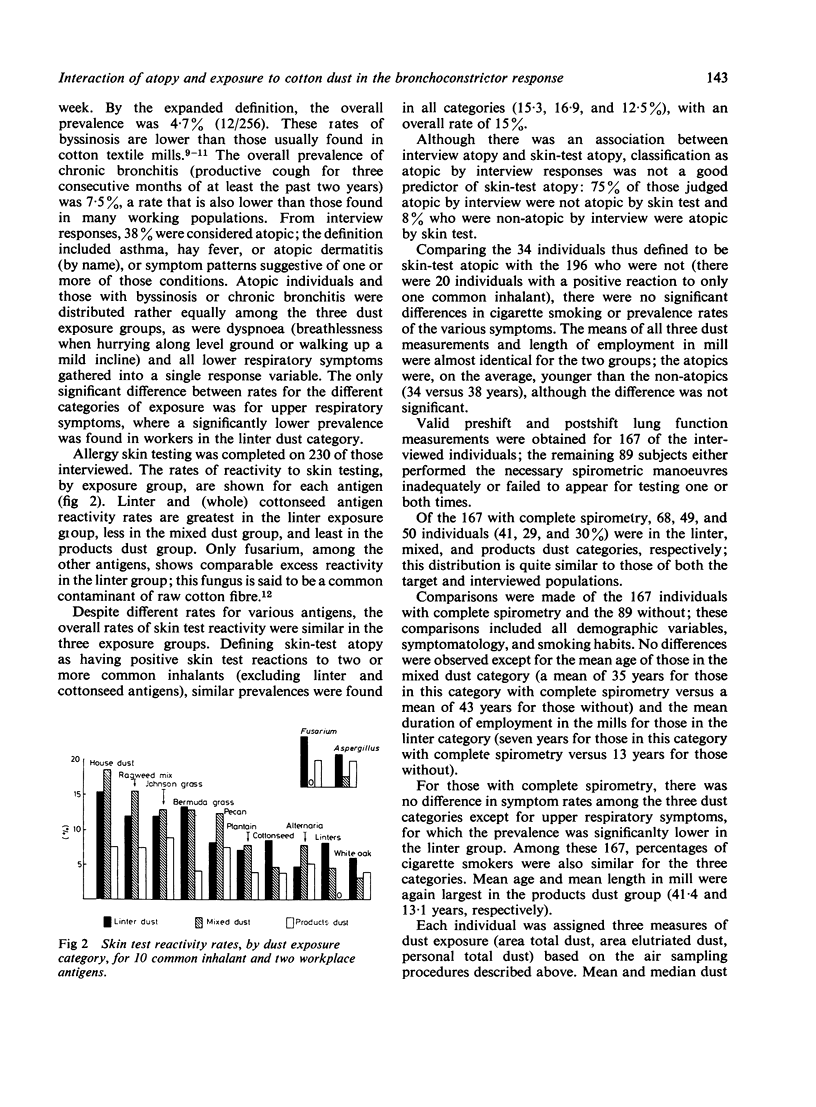
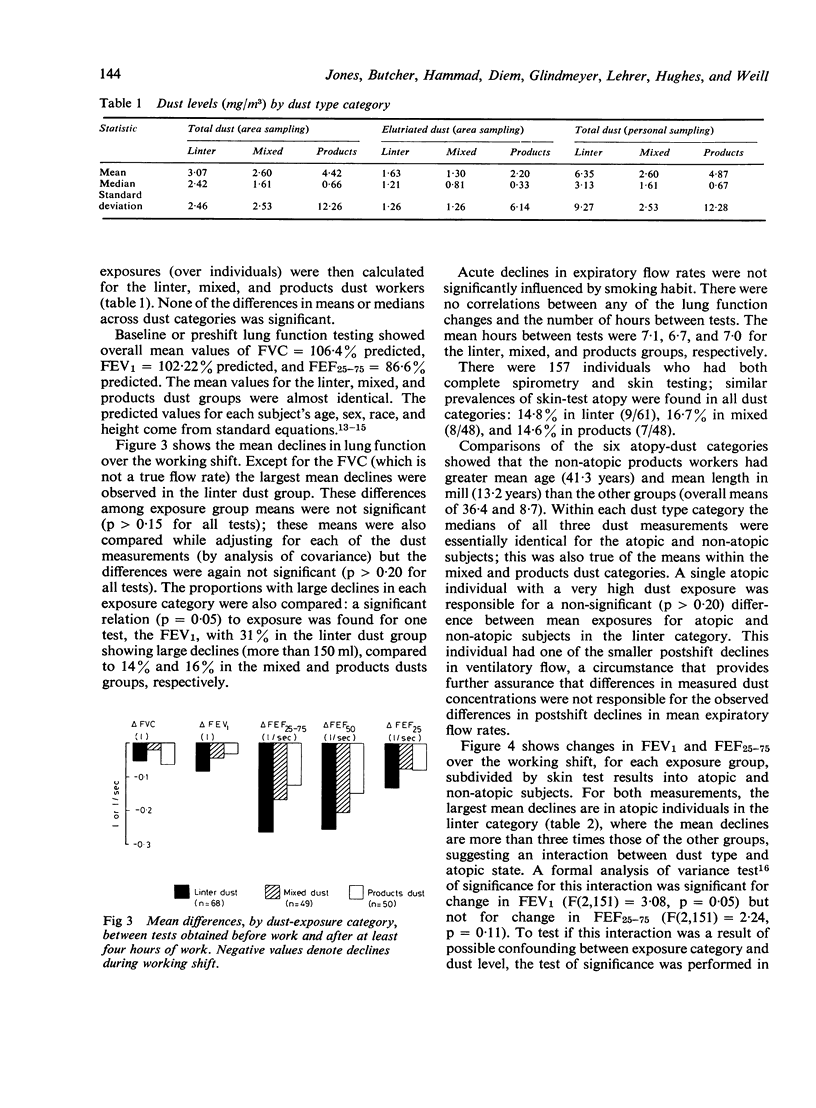
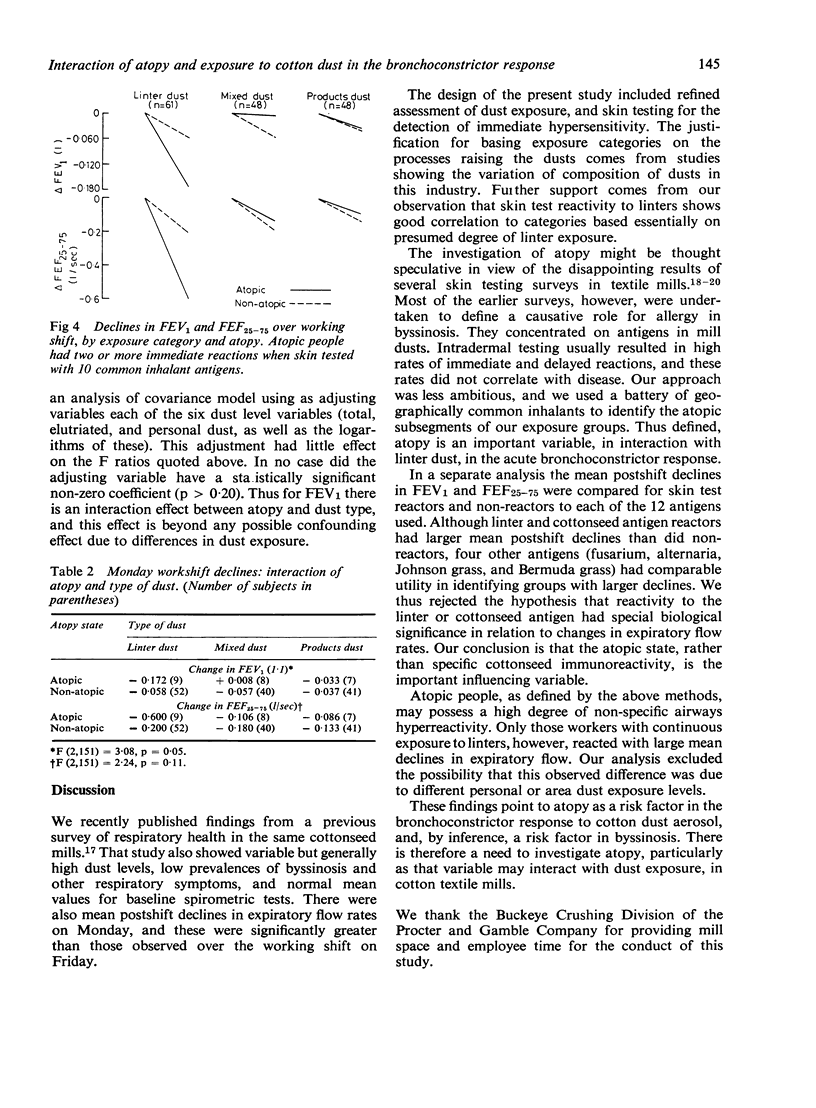
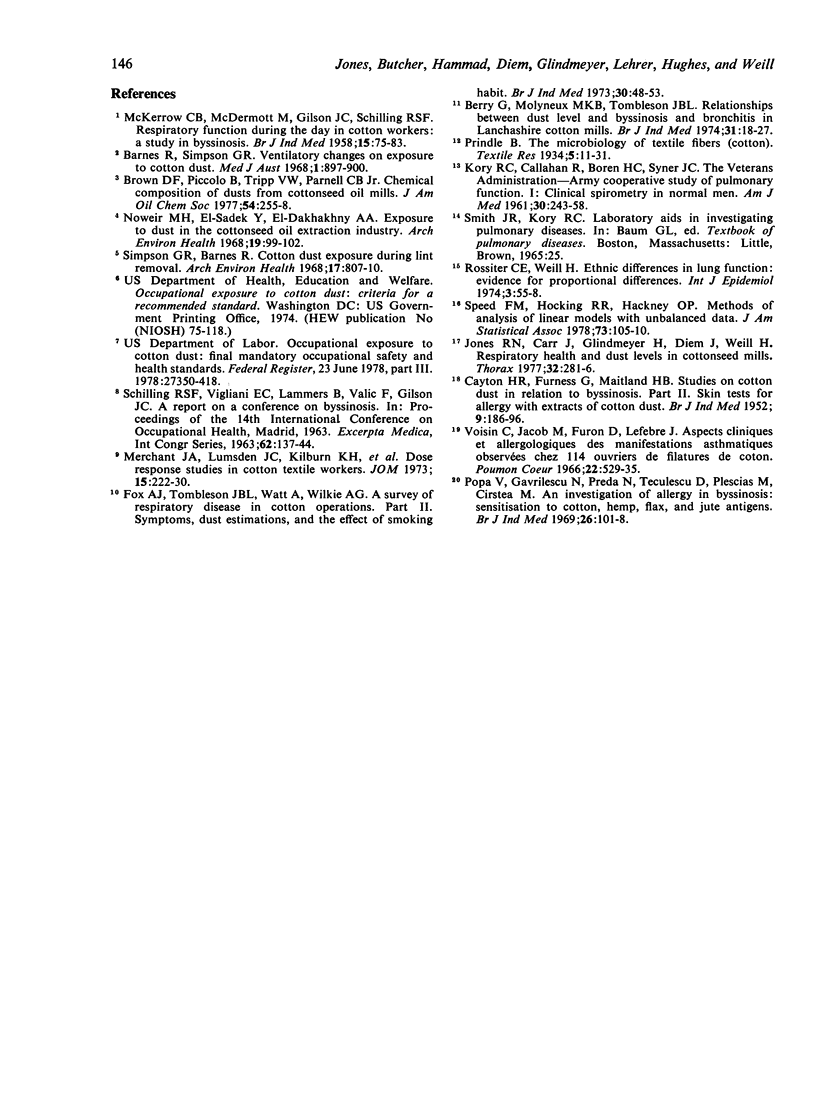
Selected References
These references are in PubMed. This may not be the complete list of references from this article.
- Barnes R., Simpson G. R. Ventilatory capacity changes on exposure to cotton dust. Med J Aust. 1968 May 25;1(21):897–900. doi: 10.5694/j.1326-5377.1968.tb29001.x. [DOI] [PubMed] [Google Scholar]
- Berry G., Molyneux M. K., Tombleson J. B. Relationship between dust level and byssinoiss and bronchitis in Lancashire cotton mills. Br J Ind Med. 1974 Jan;31(1):18–27. doi: 10.1136/oem.31.1.18. [DOI] [PMC free article] [PubMed] [Google Scholar]
- Brown D. F., Piccolo B., Tripp V. W., Parnell C. B. Chemical composition of dusts from cottonseed oil mills. J Am Oil Chem Soc. 1977 Jun;54(6):255–258. doi: 10.1007/BF02655166. [DOI] [PubMed] [Google Scholar]
- CAYTON H. R., FURNESS G., MAITLAND H. B. Studies on cotton dust in relation to byssinosis. II. Skin tests for allergy with extracts of cotton dust. Br J Ind Med. 1952 Jul;9(3):186–196. doi: 10.1136/oem.9.3.186. [DOI] [PMC free article] [PubMed] [Google Scholar]
- Fox A. J., Tombleson J. B., Watt A., Wilkie A. G. A survey of respiratory disease in cotton operatives. II. Symptoms, dust estimations, and the effect of smoking habit. Br J Ind Med. 1973 Jan;30(1):48–53. doi: 10.1136/oem.30.1.48. [DOI] [PMC free article] [PubMed] [Google Scholar]
- Jones R. N., Carr J., Glindmeyer H., Diem J., Weill H. Respiratory health and dust levels in cottonseed mills. Thorax. 1977 Jun;32(3):281–286. doi: 10.1136/thx.32.3.281. [DOI] [PMC free article] [PubMed] [Google Scholar]
- KORY R. C., CALLAHAN R., BOREN H. G., SYNER J. C. The Veterans Administration-Army cooperative study of pulmonary function. I. Clinical spirometry in normal men. Am J Med. 1961 Feb;30:243–258. doi: 10.1016/0002-9343(61)90096-1. [DOI] [PubMed] [Google Scholar]
- McKERROW C. B., McDERMOTT M., GILSON J. C., SCHILLING R. S. Respiratory function during the day in cotton workers: a study in byssinosis. Br J Ind Med. 1958 Apr;15(2):75–83. doi: 10.1136/oem.15.2.75. [DOI] [PMC free article] [PubMed] [Google Scholar]
- Merchant J. A., Lumsden J. C., Kilburn K. H., O'Fallon W. M., Ujda J. R., Germino V. H., Jr, Hamilton J. D. Dose response studies in cotton textile workers. J Occup Med. 1973 Mar;15(3):222–230. [PubMed] [Google Scholar]
- Noweir M. H., el-Sadek Y., el-Dakhakhny A. A. Exposure to dust in the cottonseed oil extraction industry. Arch Environ Health. 1969 Jul;19(1):99–103. doi: 10.1080/00039896.1969.10666810. [DOI] [PubMed] [Google Scholar]
- Popa V., Gavrilescu N., Preda N., Teculescu D., Plecias M., Cîrstea M. An investigation of allergy in byssinosis: sensitization to cotton, hemp, flax and jute antigens. Br J Ind Med. 1969 Apr;26(2):101–108. doi: 10.1136/oem.26.2.101. [DOI] [PMC free article] [PubMed] [Google Scholar]
- Rossiter C. E., Weill H. Ethnic differences in lung function: evidence for proportional differences. Int J Epidemiol. 1974 Mar;3(1):55–61. doi: 10.1093/ije/3.1.55. [DOI] [PubMed] [Google Scholar]
- Simpson G. R., Barnes R. Cotton dust exposure during lint removal. Airborne dust concentrations and effect of the ventilatory capacity of exposed workers. Arch Environ Health. 1968 Nov;17(5):807–810. doi: 10.1080/00039896.1968.10665323. [DOI] [PubMed] [Google Scholar]
- Voisin C., Jacob M., Furon D., Lefebvre J. Aspects cliniques et allergologiques des manifestations asthmatiques observées chez 114 ouvriers de filatures de coton. Poumon Coeur. 1966;22(5):529–538. [PubMed] [Google Scholar]


